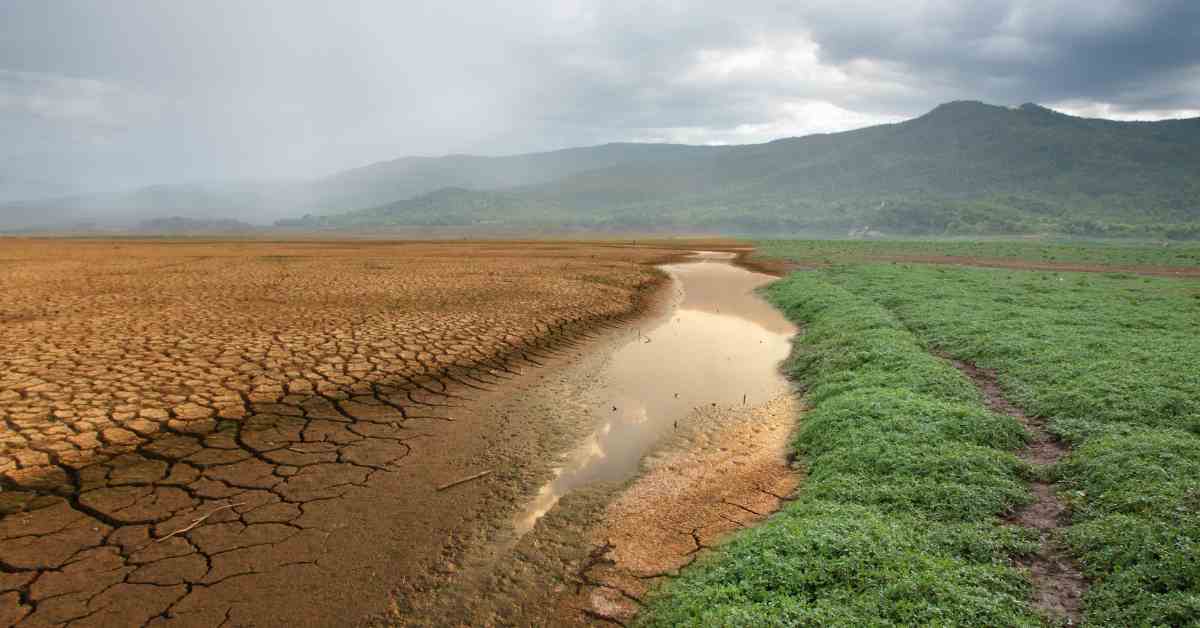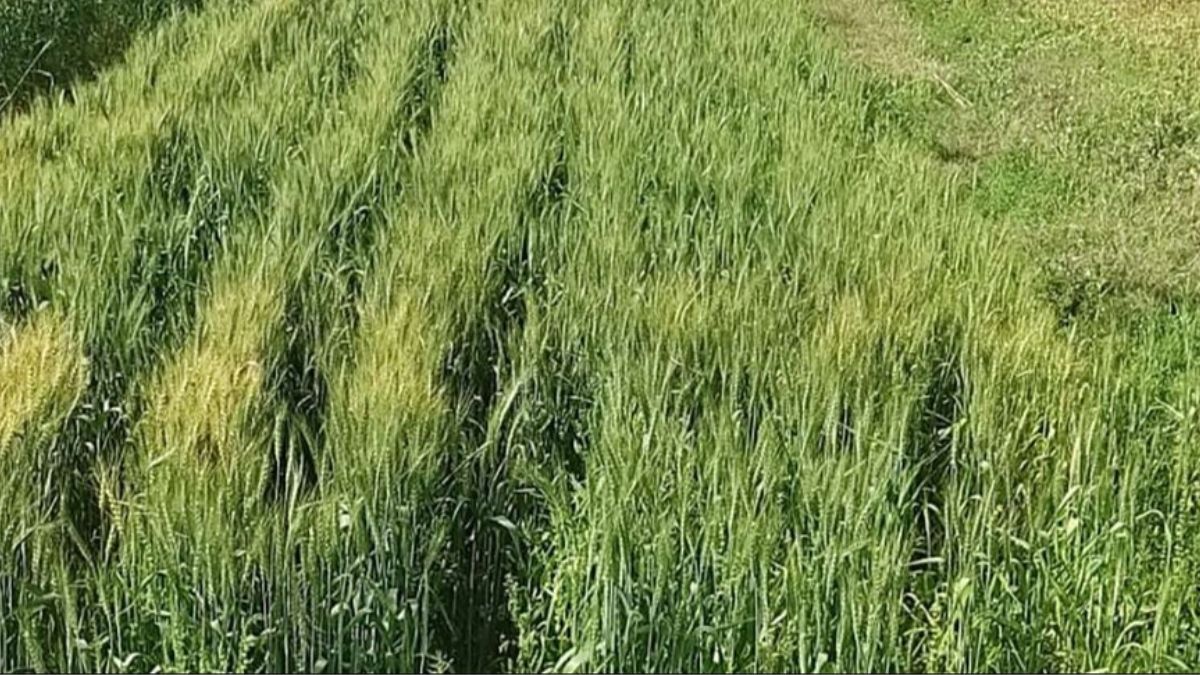Wheat is a staple crop that requires specific soil management and fertilization practices to achieve ...
Temperature fluctuations have a direct impact on wheat farming. It affects sowing, growth, grain formation, and the quality of production. These effects can be significantly reduced by adopting climate-resilient agricultural techniques, selecting modern crop varieties, maintaining balanced nutrient management, and implementing proper irrigation measures.
तापमान में उतार-चढ़ाव का गेहूं की खेती पर प्रत्यक्ष प्रभाव पड़ता है। यह फसल की बुवाई, वृद्धि, दाना बनने और उत्पादन की गुणवत्ता को प्रभावित करता है। जलवायु अनुकूल कृषि तकनीकों, आधुनिक प्रजातियों के चयन, संतुलित पोषण प्रबंधन और समुचित सिंचाई उपायों को अपनाकर इन प्रभावों को काफी हद तक कम किया जा सकता है।
तापमान में असामान्य उतार-चढ़ाव मुख्यतः निम्नलिखित कारणों से होते हैं:
स्थानीय मौसमीय घटनाएं – पश्चिमी विक्षोभ, चक्रवात और अनियमित वर्षा भी तापमान में उतार-चढ़ाव का कारण बनते हैं।

(i) बुवाई के समय (नवंबर-दिसंबर): यदि तापमान सामान्य से अधिक रहता है, तो मिट्टी में नमी की कमी हो सकती है, जिससे अंकुरण प्रभावित होता है। इस वर्ष दिसंबर के महीने में तापमान सामान्य से अधिक रहने के कारण गेहूं में कल्ले कम बने।
(ii) वृद्धि और कल्ले फूटने का चरण (जनवरी-फरवरी): इस समय न्यूनतम तापमान 5 डिग्री सेल्सियस से नीचे जाने पर फसल के विकास की गति धीमी हो जाती है।दिन और रात के तापमान में असंतुलन होने से फसल का संतुलित विकास प्रभावित होता है।अत्यधिक कुहासा और ओस के कारण वातावरण में मौजूद नाइट्रोजन घुलकर पत्तियों पर जमता है, जिससे फसलें अधिक हरी-भरी हो जाती हैं।
(iii) फूल आने और दाना बनने का चरण (फरवरी-मार्च): इस समय अचानक तापमान वृद्धि (Heat Wave) होने पर गेहूं की परिपक्वता जल्दी हो जाती है, जिससे दाने हल्के और सिकुड़े हुए बनते हैं। अधिक तापमान के कारण गेहूं में हीट शॉक (Heat Shock) हो सकता है, जिससे दानों में स्टार्च और प्रोटीन की गुणवत्ता प्रभावित होती है। कम तापमान होने पर परागण (Pollination) प्रभावित होता है, जिससे उपज में कमी आती है।
(iv) पकने और कटाई का समय (मार्च-अप्रैल): मार्च-अप्रैल में तापमान सामान्य से अधिक बढ़ने पर प्री-मैच्योर ग्रेन फिलिंग (Premature Grain Filling) होती है, जिससे दाने का वजन कम हो जाता है। अत्यधिक गर्मी से गेहूं की नमी जल्दी सूख जाती है, जिससे उपज और गुणवत्ता प्रभावित होती है। तेज आंधी-तूफान और असामयिक बारिश से फसल गिर सकती है और गुणवत्ता घट सकती है।
यह भी पढ़ें: गेहूँ की उन्नत खेती | गेहूं की किस्में
तापमान में उतार-चढ़ाव के नकारात्मक प्रभावों को कम करने के लिए निम्नलिखित उपाय अपनाए जा सकते हैं:
(i) जलवायु अनुकूल प्रजातियों का चयन: तापमान सहिष्णु और जल्दी पकने वाली प्रजातियाँ (जैसे HD-2967, DBW-187, HD-3086) उगाई जाएं। हीट-टॉलरेंट और ड्राउट-रेसिस्टेंट (सूखा सहिष्णु) प्रजातियों का चुनाव किया जाए।
(ii) समायोजित बुवाई समय: समय पर बुवाई (10-25 नवंबर के बीच) करने से तापमान उतार-चढ़ाव के प्रभाव को कम किया जा सकता है। लेट बुवाई के लिए उपयुक्त किस्में जैसे HD-2932, DBW-90 अपनाई जाएं।
(iii) सिंचाई और नमी प्रबंधन: महत्वपूर्ण वृद्धि चरणों (Tillering, Flowering, and Dough Stage) पर उचित सिंचाई करें। मल्चिंग (Mulching) तकनीक अपनाकर मिट्टी की नमी संरक्षित करें।
(iv) उर्वरक प्रबंधन: नाइट्रोजन और पोटाशयुक्त उर्वरकों का संतुलित उपयोग करें ताकि फसल की सहनशक्ति बढ़े। जैव उर्वरकों (Biofertilizers) और ह्यूमिक एसिड (Humic Acid) का प्रयोग करें।
(v) रोग और कीट नियंत्रण: तापमान बढ़ने से झुलसा रोग (Blight) बढ़ सकता है, इसलिए सुरक्षात्मक फफूंदनाशकों (Fungicides) का छिड़काव करें। गर्मी और नमी बढ़ने से एफलिड्स (Aphids) एवं दीमक (Termites) का प्रकोप बढ़ सकता है, जिनका जैविक नियंत्रण किया जाए।

बढ़ते तापमान के कारण गेहूं की खेती को कई चुनौतियों का सामना करना पड़ रहा है, लेकिन सही प्रबंधन रणनीतियों और आधुनिक कृषि तकनीकों को अपनाकर इन प्रभावों को कम किया जा सकता है। जलवायु अनुकूल किस्मों, संतुलित उर्वरक उपयोग, समय पर सिंचाई, और कीट व रोग नियंत्रण के माध्यम से गेहूं की पैदावार और गुणवत्ता को सुरक्षित रखा जा सकता है।
Unusual temperature fluctuations mainly occur due to the following reasons:
Climate Change – Due to global warming and changes in weather patterns, abnormal temperature rises are observed during the Rabi season.
Local Weather Events – Western disturbances, cyclones, and irregular rainfall also contribute to temperature fluctuations.
(i) Sowing Period (November-December): If the temperature remains higher than normal, soil moisture may decrease, affecting germination. This year, due to higher-than-normal temperatures in December, fewer tillers developed in wheat.
(ii) Growth and Tillering Stage (January-February): When the minimum temperature drops below 5°C, crop growth slows down. An imbalance in day and night temperatures affects balanced crop development. Excessive fog and dew cause nitrogen present in the atmosphere to dissolve and settle on leaves, making crops excessively green.
(iii) Flowering and Grain Formation Stage (February-March): A sudden rise in temperature (Heat Wave) during this period accelerates wheat maturity, resulting in lightweight and shriveled grains. High temperatures can cause heat shock, affecting the starch and protein quality in grains. Low temperatures impact pollination, leading to reduced yield.
(iv) Ripening and Harvesting Time (March-April): If the temperature rises above normal in March-April, premature grain filling occurs, reducing grain weight. Excessive heat causes rapid drying of wheat moisture, affecting yield and quality. Strong winds and unseasonal rains can lead to lodging and deterioration in grain quality.
To mitigate the negative effects of temperature fluctuations, the following measures can be adopted:
(i) Selection of Climate-Resilient Varieties: Temperature-tolerant and early-maturing varieties (such as HD-2967, DBW-187, HD-3086) should be cultivated. Heat-tolerant and drought-resistant varieties should be preferred.
(ii) Adjusted Sowing Time: Timely sowing (between November 10-25) can help minimize the impact of temperature fluctuations. For late sowing, suitable varieties like HD-2932 and DBW-90 should be used.
(iii) Irrigation and Moisture Management: Proper irrigation should be done during critical growth stages (Tillering, Flowering, and Dough Stage). Mulching techniques should be used to retain soil moisture.
(iv) Fertilizer Management: A balanced use of nitrogen and potassium-based fertilizers can enhance crop resilience. Biofertilizers and humic acid should be used.
(v) Pest and Disease Control: Rising temperatures can increase the risk of blight disease, so preventive fungicide sprays should be applied. Higher heat and humidity can lead to aphid and termite infestations, which should be controlled biologically.
Due to rising temperatures, wheat farming faces several challenges. However, by adopting proper management strategies and modern agricultural techniques, these effects can be minimized. The use of climate-resilient varieties, balanced fertilizers, timely irrigation, and effective pest and disease control can help protect wheat yield and quality.
0
0
Wheat is a staple crop that requires specific soil management and fertilization practices to achieve ...
भारत में कृषि न केवल एक प्रमुख आर्थिक � ...
Neem cake is an organic byproduct derived from cold-pressed neem seeds after the extraction of neem ...
खरीफ फसलें-मानसून के मौसम में उगाई जात ...
Rice farming requires careful management of soil nutrients to ensure optimal growth and yield. The a ...
Fertilizers are essential substances used in agriculture to enhance the growth and productivity of c ...
Mango farming is a significant agricultural practice in many tropical and subtropical regions. Known ...
Organic farming is an agricultural practice that focuses on growing crops and raising livestock in a ...
Crop rotation, a key agricultural practice, involves growing different crops in the same field acros ...
Soil fertility is crucial for any farmer or gardening enthusiast. Fertile soil promotes healthy plan ...
Soil testing is a process that provides farmers with crucial information about the quality, nutrient ...
The tradition of farming in India is centuries old, and wheat and barley hold significant importance ...
The Aak plant (Calotropis gigantea) is a remarkable creation of nature, valued for its distinctive f ...
Roses, known for their beauty and enchanting fragrance, are the pride of every garden. However, main ...
Agricultural Pollution refers to the harmful effects caused by agricultural activities on the enviro ...
During summer, rising temperatures increase the risk of fire in wheat crops. As April begins, wheat ...
Agroforestry is a term derived from two words: "Agriculture" and "Forestry." It is a land-use system ...
कृषि में आर्टिफिशियल इंटेलिजेंस (AI) क ...
Contour Farming is a very common farming technique practiced in India. It is commonly practiced in h ...
Vegetables to Sow in May : Dear farmer friends, in the month of May, our plants don't usually suff ...
Papaya is a highly nutritious fruit loaded with medicinal properties. Its consumption helps regula ...
India is an agrarian country with three major agricultural seasons and a variety of crops being prod ...
Leaf curl disease, which causes leaves to curl, is a serious threat to agriculture. This disease aff ...
Intercropping is a farming method where two or more crops are grown together in the same field. It h ...
Mulching is a layer spread over the surface of the soil, primarily aimed at retaining soil moistur ...
India is an agriculture-based country, yet many farmers can’t use their land as it remains barren ...